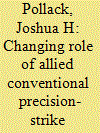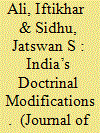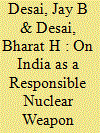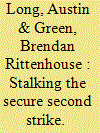| Srl | Item |
| 1 |
ID:
182636


|
|
|
|
|
| Summary/Abstract |
Multiple non-nuclear-armed states in alliances with nuclear-armed states are in the process of acquiring long-range, conventionally armed precision-strike weapons, some of which have potential to contribute to attacks on enemy nuclear forces. This change in the distribution of advanced military technologies has the unintended consequence of giving these non-nuclear-armed states an active role in strategic stability. We provide a theoretical framework for understanding the newly emerging pathways to nuclear use that result. We also investigate perceptions of the role of precision-strike capabilities in six non-nuclear-armed states at various stages in the process of developing these capabilities.
|
|
|
|
|
|
|
|
|
|
|
|
|
|
|
|
| 2 |
ID:
184119


|
|
|
|
|
| Summary/Abstract |
This paper assists in understanding contesting technological capabilities and doctrinal modification between India and Pakistan that are drifting South Asia towards instability, leaving the nuclear deterrence in a dark abyss. Hawks on both sides of the nuclear armed rivals are unprecedentedly chanting threats of nuclear war. More bothersome is the indications of shifting the Indian policy of No First Use (NFU), calls for doctrinal modifications and counterforce temptations. An Indian quest for escalation dominance and Pakistani quest for stability against India is in fact a mutual struggle beyond ‘minimum credible’ to ‘assured second strike’ capabilities.
|
|
|
|
|
|
|
|
|
|
|
|
|
|
|
|
| 3 |
ID:
180283


|
|
|
|
|
| Summary/Abstract |
India conducted Operation Shakti (Pokhran II) nuclear tests during 11–13 May 1998 that ushered her into the cherished nuclear weapons club. It was well calibrated decision to formally choose the nuclear path through the first peaceful nuclear explosion, Smiling Buddha (Pokhran I) that was conducted on 18 May 1974. It was significant that without joining the 1968 Nuclear Non-proliferation Treaty, India managed to gatecrash into the nuclear weapons capability. It led to articulation of the No First Use (NFU) doctrine on 4 January 2003 (Ministry of External Affairs [MEA], 2003). In the wake of 16 August 2019 pronouncement of the Indian Defence Minister on possible review of the NFU, this article seeks to probe the question: Does the NFU doctrine require any such review? It comprises the rational, the promise of NFU, counterforce strategies, NFU with respect to tactical nuclear weapons and associated problems with First Use and NFU.
|
|
|
|
|
|
|
|
|
|
|
|
|
|
|
|
| 4 |
ID:
137242


|
|
|
|
|
| Summary/Abstract |
Secure second strike nuclear forces are frequently held to be easy to procure. Analysts have long argued that targeting intelligence against relocatable targets like submarine launched and land mobile ballistic missiles is difficult to obtain. However, the scholarly consensus on intelligence for counterforce operations is seriously overdrawn. Both during and after the Cold War, the United States developed substantial intelligence capabilities to track and target submarines and mobile missiles. These efforts achieved important and under-appreciated success. Second strike forces have been far more vulnerable than most analysts are willing to credit.
|
|
|
|
|
|
|
|
|
|
|
|
|
|
|
|